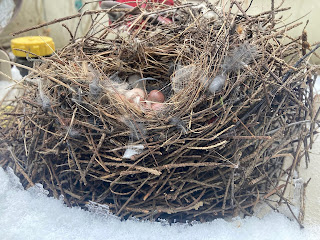Can
you identify what's in this photo?
Each Wednesday morning
on Camp Lutherlyn's Facebook page
the Lutherlyn Environmental
Education Program posts a photo.
Readers
have all morning and afternoon
to
make their best guess about what the photo is.
Around
6 pm LEEP provides the answer and a brief explanation.
Each
week's What is it Wednesday post
will
also be posted on the Nature of Lutherlyn blog,
after it is posted on Facebook,
sometimes
with additional bonus information.
In
addition to bringing you current editions of What is it Wednesday
on the
Nature of Lutherlyn blog,
we
will be reposting old editions,
creating
a What is it Wednesday archive.
This photo was posted as a What is it Wednesday on
February 24, 2021.
And
the answer is....
This is an abandoned nest of a house wren, which was built
under
the lid of thepropane tank at Lutherlyn's Terra Dei Homestead.
(It was discovered when we
needed to check
the level of the tank a week or two ago.)
It’s not clear why the nest was abandoned, or why one of the eggs has a hole in it and the others were left intact. When a baby bird emerges from its egg the egg is usually broken fully into two or more pieces, but this egg only has a small hole in it. If a predator ate the egg, why didn’t it eat the rest of them? Perhaps the mother bird was unable to return to the nest to continue incubating the eggs, and when an animal discovered the eggs some time later it broke into the eggs looking for a meal but discovered they were empty. It is unclear what happened but it was an interesting surprise to find a nest with eggs in it in the dead of winter. It this area, only large birds like owls and eagles are incubating eggs in a nest this time of year.
It is pretty clear that this is the nest of a house wren, because it is built of a platform of coarse sticks with a small lining of smaller twigs, grasses and feathers in the center of the nest.
The number, size, shape and color of the eggs also match that of house wren nests.
House wrens are also well-known for building nests in any unusual protected nook they can find. Peterson’s Field Guide to Bird’s Nests says they have been recorded as nesting in “radiator of unused auto, top of pump, empty cow skull, leg of work pants on clothesline, flowerpot, pocket of scarecrow, boots, shoes, in or on nests of other birds.” Here they found a well-protected area completely covered by the cap covering the propane tank controls. With the cap in place, you can just barely see the bottom twigs poking out of the gap at the bottom. No wonder we didn't see the nest until February!
If you find a bird nest, noting the size, shape, building materials and location of the nest will help you identify what type of bird has built it. If the nest has eggs in it, the size, shape, color and number of eggs will also narrow things down. Keep an eye out and you may find bird nests in both surprising and expected locations, and in nesting season and all year long.
Like and follow Camp Lutherlyn on Facebook, to see What is it Wednesday posts when they come out and have the opportunity to share your guesses in the comments!






No comments:
Post a Comment